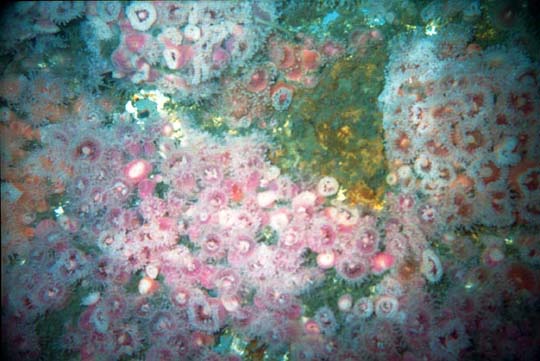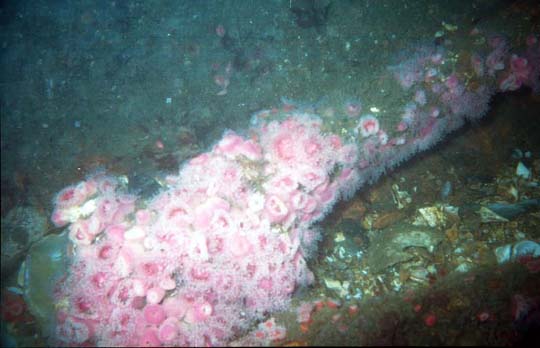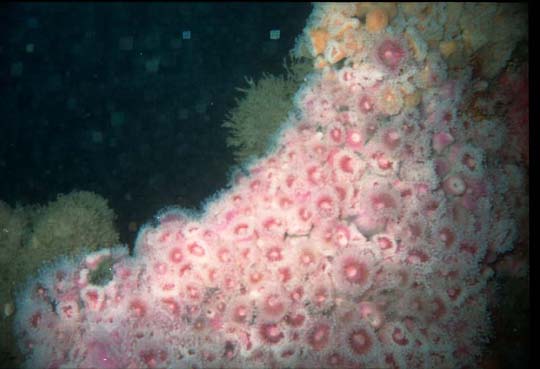Wreck Alley on the Lois Ann
CopyRight @ 1998
I made a dive on this wreck more than a year ago. I don't care about wrecks. They are usually dead. When I saw the Ruby E the first time, I couldn't believe my eyes. Its complete covering of brilliantly colored Corynactis Anemones, made it easily one of the most beautiful sites I had ever seen under water. I remember once, basically crawling under a rock at Santa Rosa Island in an attempt to photograph a six inch patch of purple anemones. Here was a 170 foot Coast Guard Cutter, covered from bow to stern with them. They are usually from one, maybe two inches tall and half that across. Every color was there. There were reds, pinks, purples, lavenders, whites and even some yellow patches. They are called Strawberry Anemones, but there is every shade of red and pink. The bodies and the tentacles of the anemones may be different colors as well.
Click on any picture to see a larger image.
These Anemones grow by division, so each color makes up a patch about a foot square. There is some overlap and biologists love to study the slow motion warfare between the patches.
The wreck itself is interesting enough. It is easy to swim along the walkway to the bridge. Swimming through the wheelhouse just seemed to make sense. The other divers didn't seem to be stirring up the water much, so vis remained OK. The ships communication mast had been cut so that it would fall down across the cabin. It probably was tall enough to be a hazard to surface vessels. The hold was open and easy to enter, but I had a bit more caution than I did lights, so I just looked in. As you drift along the wreck, almost every surface is covered with the brilliant anemones. I eventually went back to the mooring line at the stern and moseyed back to the surface. I figured I had to come back with my camera.
The Ruby E is one of 7 vessels intentionally sunk off of Mission Bay in San Diego. Some like the Ruby E and the Del Rey, a kelp cutter, are regularly visited by local divers and Dive Charters. There are plans to sink the 366 foot Canadian Destroyer "Yukon" in about 100 feet of water. That would be something.
So here I am again on the Lois Ann heading for the Ruby E. Circumstances had kept me away for well over a year. El Nino had made California diving poor for much of the winter and I wanted to dive, even if I was tired. Oh. I see. It's also bumpy today... Where did this weather come from in late May? Luckily, it's a short ride and the Lois Ann is pretty comfortable. There had been the boat briefing and the dive briefing, now there was a short discussion about the wreck by the DM.
I didn't really hurry any to get off. I've never had an anemone get away from me yet. The easiest way down is to follow the line down from the buoy at the stern. Vis looked lousy today. I ended up at the stern railing in about 60 feet and sure enough, the anemones were there and just as colorful. I had a 36 shot roll of film and fresh batteries. There was a large school of perch and various bass over the entire back of the boat. Neat, but I did not expect them to stay on the boat very long with all these divers. Some of the sand bass were pretty big. I would love to get one of them on a line.
Well, it was time to get down to business. I wanted to finish that roll on this dive and get it developed right away. I set for close up and sorta took a practice shot at a patch of some really red anemones. Click, flash, whatever. Hmmm. I'm not sure I felt the film wind. Click.. No click, no flash........ No more click in camera. I won't write the word here. You can fill it in.

All ready to play and no one brought the ball. I turned on my light and went sight seeing. Looking closely at the anemones reveals beautiful delicate features. Damn. In my light the colors are incredible. There are even some yellowish ones like none I have seen before. Every minute or so, I gave my camera another squeeze to see if by chance it might start working again.
The vis is poorer than the first time I was here. That made it dim enough that I had no inclination to enter the wreck. I checked out the Fish and Game plaque at the front of the bridge. That is the only thing that is kept clean. Along one railing was a scallop. It would have made a nice pic.... The railings are somewhat deteriorated now. In 10 years they may be gone. most of the flat surfaces are fairly clear of growths. Every vertical surface is covered in Corynactis, with occasional feathers and worms. It is fun to swim along the communication mast and see what is there. I came back to the stern. Some divers were coming out of the engine room. I figured that it was time to head up. It was a beautiful dive as it had been the first time there, but I was so psyched up to get some good pictures. I will be back.
The Lois Ann is the easiest way to get to a dive on these wrecks. They go there a few times a week if there is OK weather. It is a really comfortable boat, designed perfectly for the local San Diego diving. They supply tanks and weight belts, and they can supply a variety of rental gear. Entry, exits and fills are easy. They have probably the best Nitrox system on the coast. What really makes the boat nice though is the people that run it. Lois and Larry take very good care of their customers and the food is good. Try her white chocolate chip cookies after lunch.

They can be contacted at the Lois Ann Web Site or by phone at 619-450-4478. Another good San Diego Dive boat has a site at - One-Eyed Jack.
I made it back to the Ruby E on the Lois Ann again about a year later. I really wanted to take pictures. We visited the Yukon and then the Lois Ann. Diving was difficult with almost no visibility and an extremely strong surge. The Ruby E is more deteriorated and many of the colorful filter feeders that cover it are gone. The result of too much diver visitation I think. They are still thick in places though, like around the wheel house, so I did manage to take the pictures on this page. While I don't claim to be the greatest photographer, I can take better pictures than these. I finally decided that some of the blurriness and other poor features of the pictures were actually a result of the poor visibility. These were all taken close up at a distance of a foot, but the visibility was so bad that it effected the final pictures. I still think that they are OK and show the incredible colors of the Corynactis anemones. I hope that you like them. I guess I'm just going to have to go back and get better pictures.
 |
 |
 |
 |
 |
 |
 |
 |
 |
Back To Home Page